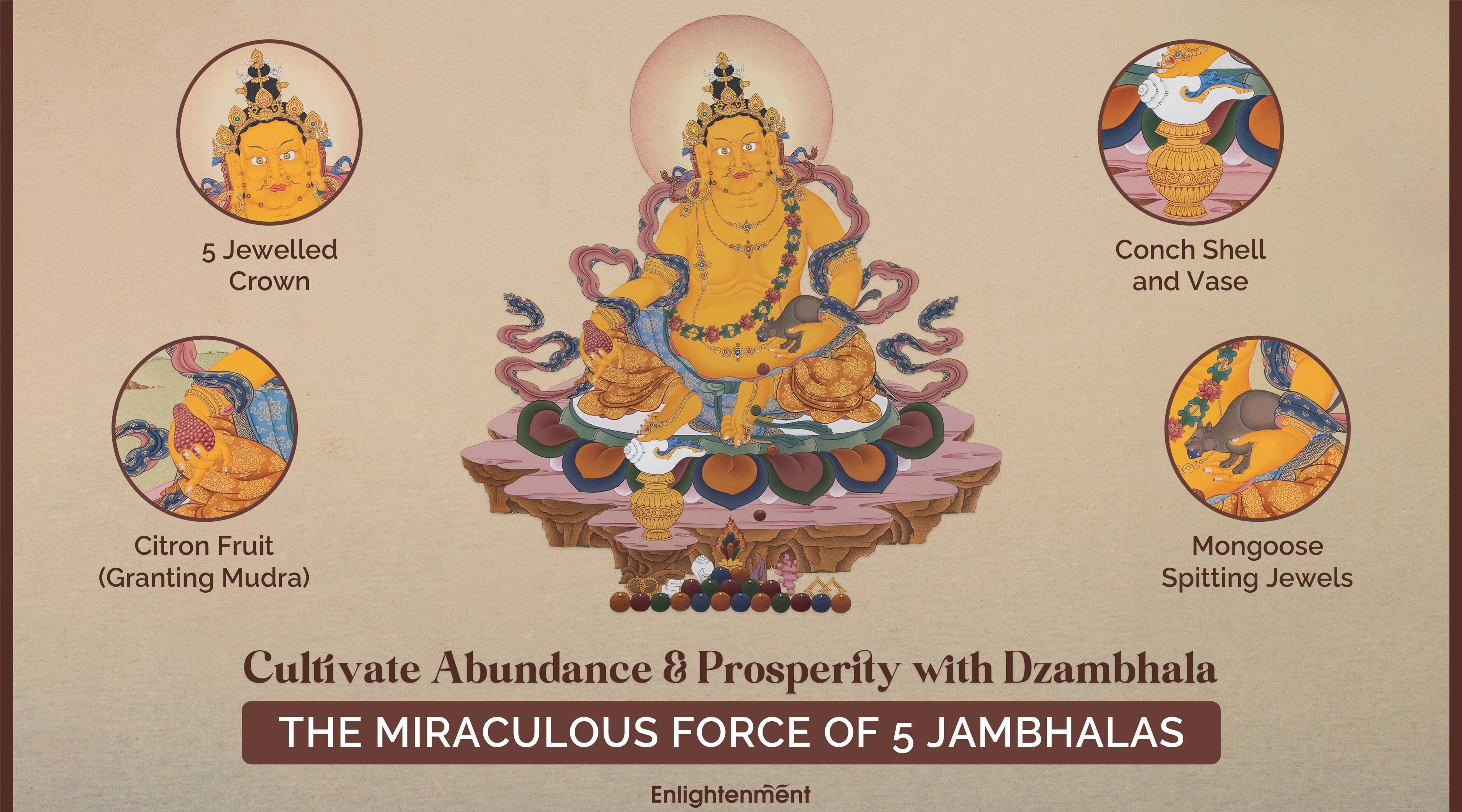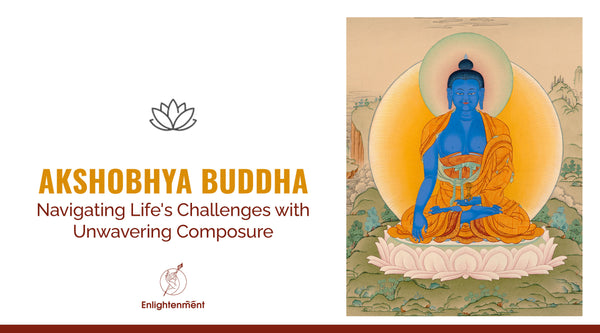Dzambhala: Your Path to Wealth, Happiness, and Spiritual Fulfillment
Jambhala is a jewel family member who is the ultimate emblem of good fortune, abundance, and achievement. Different names, such as Dzambhala, Zambala, Jambala, Namtose, and Dzambala, are often refered to him. He is believed to be a manifestation of the compassion bodhisattva Avalokiteshvara (Chenrezig). He is often compared to Kubera in Hinduism.
The word Dzambhala can be broken into three syllabels- Dzam means "assembly" or "deity," Bhah means "Gold or wealth," and La means "To honor." So Dzambhala means
"precious golden deity who gathers or distributes spirituality or Dharma with material stability or accomplishment to our circumstances."
Dzambhala helps us eradicate catastrophes and obstacles, enhancing good fortune and serenity. It suggests that owning Dzambala artwork will bring its owner wealth and prosperity. As a supernatural entity and the king of the North, he has sought out Buddha and acquired an inner state most like nirvana. Now, the deity acts as a celestial protector and defender of all sentient beings out of profound love and kindness.
Significance of Dzambhala in Buddhism

Click here to view our hand-crafted Dzambhala Statue
The primary role of Jambhala in Buddhism is that of the bodhisattva or deity of wealth and prosperity. To get material wealth, financial security, and success, practitioners frequently seek his blessings and practice. This is done with the knowledge that riches can finance both selfish and charitable endeavors, enhancing both-one's own and others' well-being.
While pursuing worldly prosperity is one part, Jambhala teachings strongly emphasize developing a giving and compassionate mindset.
Jambhala is also thought to possess the ability to conquer internal and external challenges. This involves problems with money but also includes spiritual roadblocks and hindrances that can prevent one from moving forward on the path to enlightenment.
Dzambhala Iconogaphy in Thangka Painting
Click here to view our High-Quality Jambhala Thangka Collection
Dzambhala in the thangka is often depicted seated on a lotus throne. This signifies the deity's harmony with purity and enlightenment. One of the standard art forms of Jambhala is Yellow Jambhala with a radiant yellow complexion. The deity is adorned with divine ornaments such as necklaces, crowns, anklets, and bracelets.
He holds mongoose spitting jewels in his left hand. This symbolizes his ability to bestow wealth and abundance upon his devotees. The mongoose and jewels also represent the conversion of evil forces into good ones, highlighting his capacity to relieve pain. On the right hand, a fruit or fruit-filled vase symbolizes the granting of spiritual & material wishes.
Intricate patterns, celestial beings, or other symbolic elements may be present in the background of the thangka to represent the abundance and uplifting energy that Dzambhala bestows upon his devotees.
Five Jambhalas & Their Significance
Beyond basic symbolism, the number five holds special significance. It aligns with the five cosmic elements- Earth, water, fire, air, and space, as they are in harmony with each other in Tibetan Buddhism. The five Dzambhalas are in tune with these forces of nature and the cosmos, resonating with them. This connection strengthens their ability to offer blessings that impact all facets of life.
Each Dzambhalas represents a different aspect of prosperity, generosity, protection, development, and abundance. Their harmony broadens the range of wealth, ensuring no part of abundance is overlooked.
Yellow Dzambhala
One of the most potent and renowned wealth deity is the Yellow Dzambhala, believed to be an emanation of the Buddha Ratnasambhava. Operating across six realms, he possesses the power to eradicate poverty while simultaneously enhancing virtues, longevity, and wisdom. His iconic portrayal features him seated upon a lotus within a moon disc, donning an expression that balances between serenity and strength, adorned in shining gold.
Dressed in silk attire and crowned, Yellow Jambhala exudes opulence through intricate gold ornaments and exquisite jewelry. He is positioned regally on a throne, holding a mongoose in his left hand and a Bijapuraka (citron) fruit in his right. The mongoose, representing Jambhala's triumph over the Nagas, continually emits invaluable gems and wealth, further underscoring his ability to bestow abundance.
Yellow Dzambhala Mantra
"Om Jambhala Jalendraye Svaha"
Green Dzambhala
Among the five Jambhalas, Green Jambhala stands out as the most prominent figure. This manifestation represents Buddha Amoghasiddhi, often depicted standing atop a corpse while holding a mongoose in his left hand and a Kapala in his right. In many portrayals, he is accompanied by his consort and a mongoose that generates precious jewels. The body of Green Jambhala is tinged with a bluish-green hue. Positioned in the vajra posture with a Dakini before him, his right leg is bent, and his foot rests above a snail and a lotus blossom. His left hand clutches a mongoose named Nehulay, which emits jewels from its mouth, while his right hand holds a jewel-spouting Norbu.
In a unique commitment, Green Dzambhala has vowed to safeguard those who recite his mantra or invoke his name. When confronted with difficulties, one should sincerely chant the mantra within one's heart.
Green Jambhala Mantra
"Om Karma Jambhala Ah Svaha"
White Dzambhala
White Jambhala, also known as Dzambhala Gapee in Tibetan and Guan Yin, is the compassionate embodiment of the Bodhisattva Chenrezig. This benevolent figure can confront poverty and illness, cleanse negative karma and karmic obstacles, ward off misfortune and sickness, and nurture the growth of the bodhicitta mind. In a tale from Tibetan mythology, the revered high lama Atisha encountered a severely emaciated man while wandering alone. Despite his efforts to find sustenance, he resorted to selflessly cutting flesh from his own body to offer to the starving individual. Remarkably, the man declined to consume the offered meat. With a heavy heart and uncertainty about how to aid the man on the brink of death, Lama Atisha sat by his side, grappling with a sense of helplessness.
White Jambhala Mantra
"Om Padma Krodha Arya Jambhala Hridaya Hum Phat"
Red Dzambhala
Red Jambhala is often depicted engaged in practice alongside his consort, the celestial mother of wealth who presides over prosperity in the human realm. Historically, this deity found favor primarily among kings and royalty. His practice is relevant to individuals in positions of high authority or those aspiring for such status. It possesses the capability to attract people, riches, and renown. By embracing this practice, one can experience abundant wealth and earn respect and support from others. Additionally, the magnetizing technique associated with Red Jambhala can bestow marital happiness and foster family harmony.
Red Jambhala is a manifestation of Vajrasattva, featuring two faces and four arms while holding a treasury mongoose in his left hand. Referred to as Dzambhala Mapo in Tibetan, earnestly reciting his mantra grants protection and paves the way for wealth accumulation, leading to a fulfilling and esteemed life.
Red Jambhala Mantra
"Om Jambhala Jalendraye Dhanam Medehi Hrih Dakini Jambhala Sambhara Svaha"
Black Dzambhala
The Black Jambhala recognized as the Hindu God of Wealth, Kubera. Emerging from the river, Kubera bestowed the wisdom of generating wealth upon a struggling king grappling with profound financial challenges. In addition to aiding the needy, he extends his beneficence to those engaged in solitary contemplation, possessing virtuous intentions. This divine entity, a manifestation of Amoghasiddhi Buddha at the behest of Buddha Shakyamuni, arose to propagate the Dharma and alleviate the suffering of sentient impoverished people.
Black Jambhala facilitates the flawless accomplishment of endeavors, purges misfortune, and hindrances, guards against theft and financial losses, and thwarts the accumulation of bad debts. Cloaked in black, he stands over a human form, a symbolic gesture to subdue ego and quell greed. With his right hand clasping a Gem Pot and his left cradling Nehulay, the deity wears a serpent necklace.
Reciting Black Jambhala's mantras ushers in prosperity and fulfills heartfelt wishes, paving the way for happiness. He is represented standing upon a corpse, clutching a mongoose in his left hand and a Kapala in his right.
Black Dzambhala Mantra
"Om Jambhala Jalendraye Bashu Dharini Svaha"
The Five Dzambhalas are a comprehensive view of prosperity in Tibetan Buddhism. From monetary abundance to ethical accumulation, protection, transformation, and enticement, each Dzambhala deity represents a specific facet of prosperity. The worship of these deities illustrates the interdependence of different types of prosperity and the conviction that living virtuously can result in worldly success and spiritual development.



1 comment
Nmeribe Nwasinachi success
How can I get in touch with God of jambhala